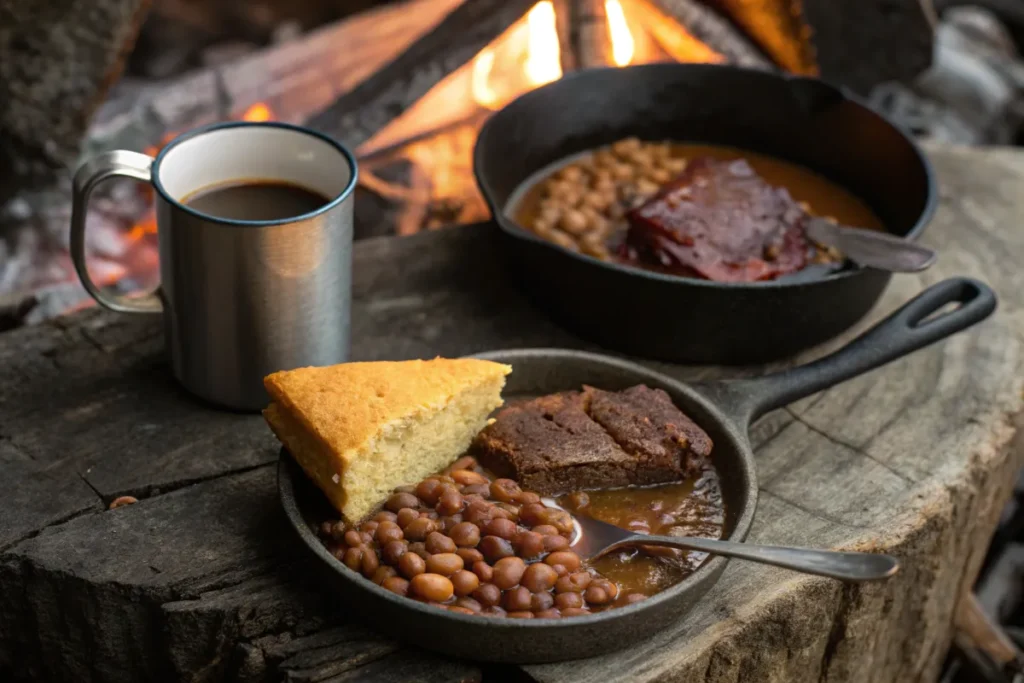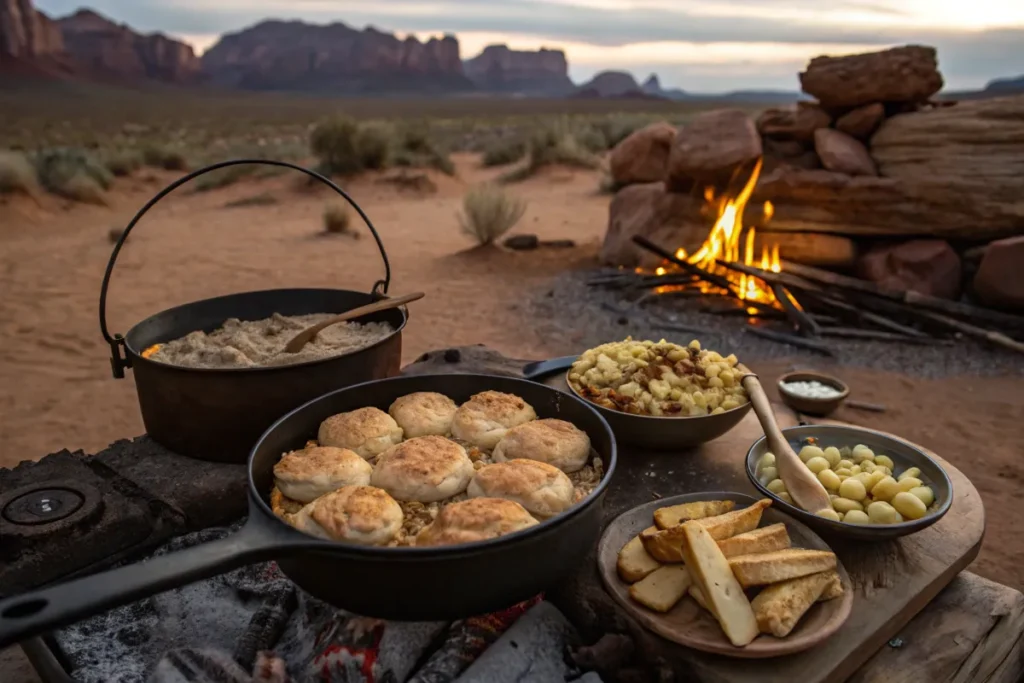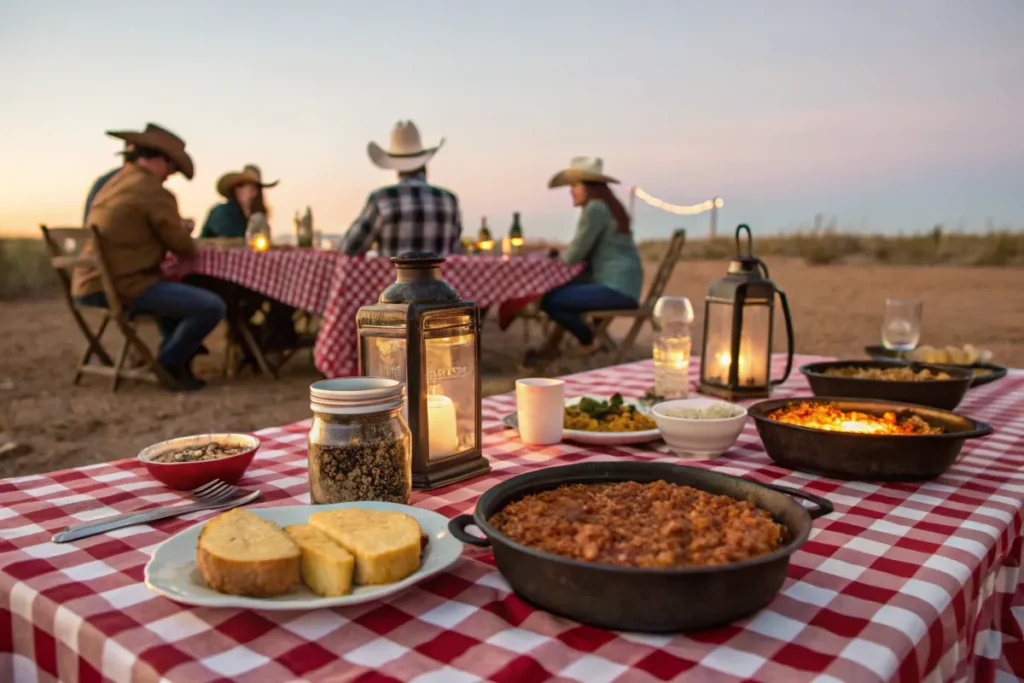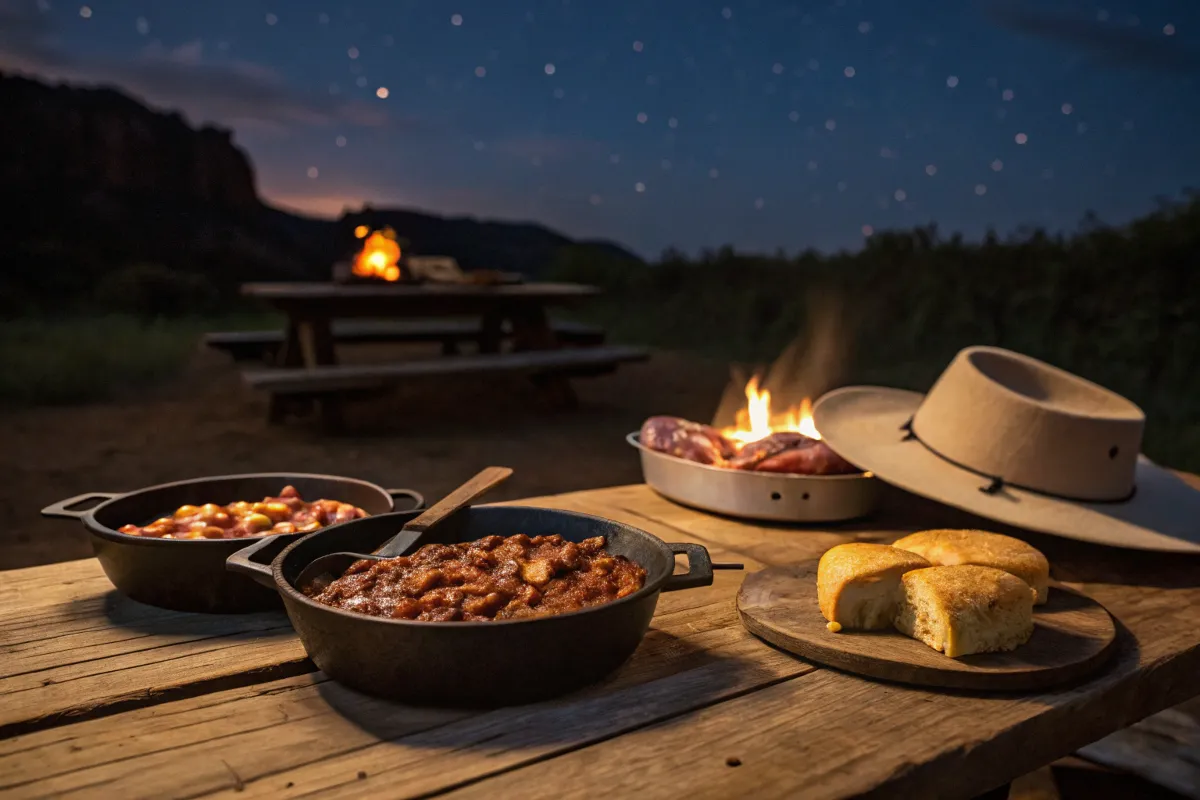Introduction
When you hear the word cowboy, what comes to mind? Probably wide-open plains, dusty boots, and roaring campfires under the stars. But beyond the grit and glory of cowboy life, there’s something just as iconic—cowboy food. So, what is a typical cowboy dinner? It’s a hearty, rustic meal built for fuel, flavor, and simplicity.
In this article, we’ll dig into the traditional roots of cowboy cooking and uncover what fueled long days on the range. From classic chuckwagon meals to modern cowboy casseroles, we’ll break down every element—meats, sides, and even desserts. You’ll also find out how to recreate these Western-style dinners at home, even if you’ve never set foot on a ranch. And yes, we’ll even show you how to throw your very own cowboy-themed dinner night that’ll have guests yelling “Yeehaw!” before dessert.
So, if you’ve ever asked yourself, “What is a typical cowboy dinner?” — grab your plate, pull up a seat by the fire, and let’s get started.
Introduction to the Cowboy Dinner Legacy
What Is a Typical Cowboy Dinner?
A typical cowboy dinner wasn’t about fancy presentation or gourmet ingredients. Instead, it was all about keeping hungry, hard-working cattlemen fed and energized. So, what is a typical cowboy dinner? It’s a meal made up of simple, filling foods—usually cooked over an open fire and served hot from a pot or skillet. These meals needed to be easy to prepare, store, and transport across rough terrain.
The usual suspects? Beans, beef, biscuits, and black coffee—all staples in any chuckwagon kitchen. These dishes were not only budget-friendly but also hearty enough to keep cowboys going during long hours of herding cattle or traveling across the dusty plains.
Today, when people search what is a typical cowboy dinner?, they’re often surprised to discover how much of it still shows up in modern kitchens. From slow-cooked briskets to campfire chili, cowboy-inspired meals are just as popular now as they were in the Wild West.
Historical Roots of Cowboy Meals
Cowboy cuisine dates back to the mid-to-late 1800s during the American Westward Expansion. On cattle drives that could last for weeks or even months, cowboys depended on one essential figure: the cookie (no, not the sweet kind). This chuckwagon cook was in charge of feeding the entire crew with limited resources and minimal tools.
Back then, meals were shaped by:
- What could be carried in the wagon (non-perishables, dried meats, flour, canned goods)
- How fast it could be cooked (because time and fuel were precious)
- How it could be reused for the next meal (leftovers were gold)
Because of these constraints, dishes like cowboy beans, salt pork, sourdough biscuits, and coffee boiled in a tin pot became the go-to essentials. These weren’t just meals—they were survival strategies.
The charm of the old West dinner wasn’t just about the food—it was the culture around it. Meals were a time for storytelling, laughter, and a bit of rest after a long day’s ride. Fast forward to today, and those traditions live on in everything from backyard BBQs to cowboy casserole night at home.
Core Components of a Traditional Cowboy Dinner
Staple Ingredients of the Wild West

So, what is a typical cowboy dinner? Let’s break it down to the bare bones of frontier food—simple, sturdy ingredients that could survive long cattle drives and unpredictable weather. The chuckwagon didn’t have room for luxury. It carried essentials only, and those essentials shaped what cowboys ate after a long ride.
Here’s what typically made it onto their plates:
- Beans: Pinto or baked beans were a staple—cheap, easy to store, and packed with protein.
- Salted meats: Think jerky, bacon, or salted pork. These didn’t spoil easily and added flavor.
- Biscuits or sourdough: Freshly baked if time and tools allowed, or cooked in a Dutch oven.
- Black coffee: Strong, bitter, and brewed over the fire—cowboys didn’t do fancy lattes.
- Dried fruit or preserved jams: For a little sweetness after all that salt.
Cowboys needed fuel, not flair. If you’re thinking what is a typical cowboy dinner today, these ingredients are still central—but often dressed up in casseroles or BBQ spreads.
Cooking Methods Used by Cowboys
Now, how did they make all that food edible with limited tools? Cowboys were practical. Their cooking methods were as rugged as their lifestyles.
They used:
- Open-fire cooking: Meat was skewered, roasted, or pan-seared over hot coals.
- Dutch ovens: These heavy cast iron pots could be buried in coals to bake everything from stews to biscuits.
- Tin coffee pots: Used to boil water and brew strong black coffee.
- Cast iron skillets: A true cowboy kitchen essential—perfect for frying bacon or crisping up potatoes.
- Simple foil-wrapping: Yes, even back then, wrapping food in metal or leaves to roast was common.
Today, we replicate this method in backyard grills or campfire cookouts, holding on to the spirit of simplicity and fire-based flavor.
👉 Want a modern twist on cowboy comfort food? Check out this cowboy casserole recipe from Bussing Recipes—it captures the same bold, hearty energy with layered meat, cheese, and crispy tots.
Cowboy Dinner Meats – From Trail to Table
Common Protein Sources
If you’re still wondering what is a typical cowboy dinner, just know this—it’s built around meat. Cowboys didn’t count macros or calories. They needed fat and protein to get through 12+ hour days on horseback.
Here were the common proteins on the range:
- Beef: Naturally, the most accessible. Cowboys often ate what they herded—think flank, brisket, or ground beef.
- Bacon and salt pork: Stored in barrels and used for nearly every meal. It added flavor to beans and filled out biscuit sandwiches.
- Wild game: On occasion, cowboys hunted deer, rabbit, or birds when herds weren’t nearby.
- Jerky: Dried meat strips, made ahead of time, were essential for eating on the go.
These ingredients made it possible to prep quick one-pan meals or fire-cooked feasts with minimal waste.
Cooking Techniques for Meat
Here’s where cowboy cooking really shines. Despite having few tools, cowboys knew how to draw out flavor using heat and time.
Their go-to methods included:
- Cast iron searing: A heavy skillet placed over the fire could deliver a perfect crust on a piece of beef.
- Slow roasting over embers: For larger cuts like brisket, this method created tender, smoky meat.
- Skewering over open flame: Think early versions of kebabs or spit-roasted game.
- Smoking: This wasn’t for taste—it was for preservation. Smoked meats lasted longer in the wild.
Interestingly, these cooking styles have made a comeback thanks to the popularity of BBQ culture, smoker recipes, and homestyle grilling techniques.
Cowboy Side Dishes and Comfort Foods
What Did Cowboys Eat with Their Meat?

When asking what is a typical cowboy dinner?, it’s easy to focus on the meat. But let’s not forget the sidekicks that turned a protein-packed plate into a full-blown meal. Cowboy side dishes were built to stretch ingredients, fill bellies, and satisfy hard workers after a long day on the trail.
These were some of the most beloved cowboy sides:
- Beans: Especially pinto or baked beans, cooked low and slow with bacon or molasses.
- Potatoes: Mashed, fried, or thrown straight into the coals—simple and filling.
- Cornbread or hoecakes: Made from cornmeal and cooked in a skillet or griddle.
- Onions and root veggies: Easy to carry and could be cooked over the fire with little prep.
- Campfire hash: A mix of meat, potatoes, and veggies fried up in one pan.
These sides weren’t just filler—they were a lifeline for energy and endurance. Today, they still appear in Southern-style dinners and grill-out gatherings, which are, in many ways, inspired by the same Wild West practicality.
Baking in the Wild: Biscuits and Breads
Now, no answer to what is a typical cowboy dinner? would be complete without freshly baked bread. Cowboys didn’t have ovens, but they did have Dutch ovens, cast iron pans, and a lot of grit.
Here’s how they got their carb fix:
- Skillet biscuits: Quick-mix biscuits cooked in cast iron with a crispy bottom and fluffy center.
- Corn dodgers: Small, dense cornbread cakes often eaten on the trail.
- Sourdough bread: Made from a starter kept alive in the chuckwagon—a cowboy’s prized possession.
- Hardtack: A long-lasting, cracker-like bread used more in emergencies.
If you’re hungry for inspiration beyond the fire, you might enjoy this beef back ribs recipe from Bussing Recipes—a rich main that would go great with skillet potatoes or baked beans.
Cowboy Dinners in Modern Kitchens
How Cowboy Dinners Have Evolved
So, what is a typical cowboy dinner today? It’s not all just open-fire and beans anymore. While the soul of cowboy cooking lives on, modern kitchens have taken that rustic simplicity and turned it into comfort food magic.
You’ll now see cowboy-style meals in:
- Slow cookers and Instant Pots
- Weeknight family dinners
- Backyard BBQ menus
- Viral TikTok casseroles
These meals are no longer about survival—they’re about flavor, nostalgia, and ease. That said, they still stick to core cowboy values: hearty portions, simple prep, and big flavor.
One example of this evolution? The beloved cowboy casserole, which layers ground beef, cheese, and tater tots into a bubbling one-pan dish. It’s a crowd favorite and the perfect answer to “what is a typical cowboy dinner” in 2025.
Looking for a modern cowboy stew with all the flavors of the frontier? Try The Pioneer Woman’s Cowboy Stew Recipe—a rich, hearty dish packed with ground beef, sausage, potatoes, and beans.
Modern Cowboy Dinner Recipes to Try
Want to bring a little Wild West charm to your table? Try these modern cowboy-inspired recipes:
- Cowboy steak: A thick-cut ribeye grilled over open flame or cast iron.
- Skillet potatoes: Crispy edges, soft centers—just like the old trail meals.
- Baked beans with brown sugar and bacon: A sweet and smoky upgrade.
- Cowboy chili: Rich with ground beef, beans, and smoky spices.
- Cowboy cornbread casserole: A hybrid of meatloaf and cornbread in one dish.
- Tater tot cowboy casserole: Cheesy, crispy, and oh-so-satisfying.
For more delicious recipe ideas, check out Bussing Recipes’ collection of cowboy-style comfort foods.
Cowboy-Inspired Dinners for Families
Making Cowboy Meals Kid-Friendly
Now, what is a typical cowboy dinner when you’re feeding picky eaters or trying to keep prep time low? Good news—cowboy-inspired meals are family-friendly by nature. Their ingredients are simple, the prep is flexible, and the flavors are comforting enough for even the fussiest mouths.
Here are a few easy ways to cowboy-up your weekly menu while keeping it kid-approved:
- Tone down the spice: Replace chili powder or jalapeños with milder flavors like smoked paprika or garlic powder.
- Use familiar textures: Swap rough cuts of meat for ground beef or shredded chicken to make dishes easier to chew.
- Build your own bowls: Let kids choose toppings like shredded cheese, sour cream, or crushed tortilla chips for their cowboy chili or casserole.
- Mini cowboy sliders: Use pulled beef or ground pork on small buns with a side of tater tots.
Not only are these meals quick to make, but they also invite creativity, which kids tend to love.
Budget-Friendly Cowboy-Inspired Meals
Beyond the fun and flavor, one big reason families love cowboy-style cooking is because it’s easy on the wallet. Historically, what is a typical cowboy dinner if not an example of doing more with less?
Here are a few budget-friendly meal ideas inspired by the cowboy lifestyle:
- Beans and rice skillet: Add in some sautéed onions and diced tomatoes for a flavorful, protein-rich meal.
- Ground beef and potato hash: A one-pan meal that’s filling, flexible, and fast.
- Cheesy cowboy pasta bake: Elbow macaroni, a meat sauce base, and a cheesy topping—baked until golden.
- Sausage and biscuit skillet: A shortcut comfort meal using pre-made biscuit dough and sausage gravy.
These recipes prove you don’t need fancy ingredients or hours of time to pull off a true Western-style dinner.
How to Host a Cowboy-Themed Dinner Night
Decor, Music, and Table Setting Tips
You’ve learned the answer to what is a typical cowboy dinner?—so why not bring it to life with a themed dinner night? Hosting a cowboy-themed meal is a fun and memorable way to celebrate birthdays, family nights, or backyard BBQs.
Here’s how to set the stage:
- Table décor: Use burlap table runners, checkered napkins, and mason jar centerpieces.
- Plates and serving dishes: Opt for enamelware or rustic-style dishware to mimic the chuckwagon look.
- Lighting: Dim the lights and use lanterns or string bulbs to create a campfire vibe.
- Music playlist: Cue up some classic Johnny Cash, Willie Nelson, or the Yellowstone soundtrack for that cowboy flair.
A few hats and boots at the door? You’re golden.
Cowboy Dinner Party Menu Ideas

So, what’s on the menu for your big night? Let’s channel the spirit of the West and plan a full-course cowboy feast.
Here’s a crowd-pleasing lineup:
- Appetizer: Cowboy caviar with tortilla chips
- Main course: BBQ ribs or cowboy steak
- Side dishes: Skillet cornbread, baked beans, and campfire potatoes
- Dessert: Dutch oven peach cobbler or skillet s’mores
- Drinks: Sweet tea, lemonade, or a fun non-alcoholic “cowboy punch”
Not only will this kind of dinner wow your guests, but it’s also a fun, interactive way to share the history and flavors of the American West.
Cowboy Dinners in Pop Culture
Influence of Shows Like Yellowstone and Western Films
Western shows and classic cowboy movies have shaped how we picture life on the trail—including what was on the dinner plate. Today, when people ask what is a typical cowboy dinner?, much of what comes to mind is thanks to Hollywood.
From John Wayne classics to modern series like Yellowstone, cowboy dinners are often shown as hearty, rustic meals shared around a fire or a long wooden table. The scenes are filled with imagery of sizzling steaks, iron coffee pots, and piles of baked beans served in enamelware plates.
These shows have made cowboy food feel both nostalgic and cool. They’ve turned simple one-pot meals into something worthy of the spotlight. And because of that, modern cowboy dinners have gained serious traction in kitchens across the country.
Social Media and Cowboy Food Trends
In today’s world, cowboy cuisine isn’t just on screen—it’s trending online, too. TikTok, Instagram, and Pinterest are bursting with reels and recipes that echo the Wild West spirit.
Some viral cowboy-themed food trends include:
- TikTok’s cowboy casserole: A cheesy, tater tot-topped one-dish dinner
- “Campfire cooking” reels: Slow-mo shots of Dutch oven biscuits and open-fire steaks
- Cowboy caviar: A zesty black bean and corn salsa that’s gained millions of views
- #CowboyDinner hashtag: Used to tag rustic, easy-to-make comfort food from real kitchens
So, if you’re wondering what is a typical cowboy dinner in 2024? It’s likely being shared, liked, and pinned online as we speak.
FAQs – What People Also Ask
The question “What is a typical cowboy dinner?” pops up in Google searches more than you’d think. Let’s answer the top follow-ups that people often want to know.
1. What is a typical cowboy dinner made of?
A typical cowboy dinner is usually made of beans, beef (or salt pork), biscuits, potatoes, and strong black coffee. These ingredients were easy to carry, cook, and fill up on, which made them perfect for life on the trail.
2. Did cowboys really eat beans and biscuits every day?
Pretty much! Beans and biscuits were the cornerstones of many cowboy meals. Since they stored well and required little equipment, they were cooked almost daily. When available, cooks would add meats like bacon or game, and occasionally some fresh bread if they had flour and time.
3. What drinks did cowboys have with dinner?
Cowboys mostly drank black coffee brewed over a fire. Water was sometimes hard to come by or not safe to drink. On rare occasions or in towns, they might enjoy whiskey or beer, but coffee was the everyday staple during meals.
4. How do I make a modern cowboy dinner at home?
Start with a protein (like steak or ground beef), add a hearty side like beans or potatoes, and finish with bread—cornbread or skillet biscuits work great. Want to keep it easy? Try a cowboy casserole or a beef and bean skillet. These modern takes are quick, budget-friendly, and family-approved.
With the spirit of the West still alive in our kitchens, there’s no need to saddle up to enjoy a slice of cowboy life. Whether you’re feeding a crew or just craving comfort, now you know exactly what is a typical cowboy dinner—and how to bring it home.

